Dyeing with picric acid yields colors between a gorgeous olive and an electric yellow.
Several years ago, I first came across a piece of tying material that was dyed with picric acid. I was walking around the tying island of the Danish Fly Festival, where Hans Weilenmann was tying tiny nymphs with gorgeous olive dubbing he was scraping off a small hide when needed. The hide in question was from a small mammal, about the size of a weasel, with a brownish yellow hue to what used to be the back of the animal, whereas the belly fur was an electric yellow I'd never seen before.


From the darkest olive to the brightest, yellowish lime. That's picric acid
Since my curiosity as to how such a strangely coloured skin could actually produce such a wonderful olive dubbing was roused, I approached Hans and asked what that skin was, and how it got to be the colour that it was. He told me that it was a pine squirrel skin, and that it was dyed using picric acid. Upon asking about the dyeing process, he replied that all he could tell me was that he had a bottle with a solution of picric acid in water, that he was given some years back, that he used to dye his skins. Being the chemist that I am, I there and then resolved to find out how to reproduce this process.
Picric acid

Picric acid
First a few words of caution. While picric acid is not immediately life threatening, it DOES warrant somewhat more care in handling and storage than your average fabric or tying material dye. Picric acid is also known as trinitrophenol, and is a close relative of TNT. Not surprisingly, it is explosive, in dry form. It is therefore stored wet, either as wet crystals, or as solution. When wet, there is NO explosion hazard. It is also reasonably reactive to biological materials (which is why it is such a good dye in the first place!), so it will almost immediately stain any part of skin with which it comes in contact, colouring it bright yellow. Therefore it is advisable to always handle picric acid with good laboratory gloves. It is not particularly toxic on ingestion, but it is not harmless. Storage of stock crystals and solutions should therefore be in a closed cupboard or room.
Dyeing

The Dalby Revenger utilizing picric acid dyed rabbit
Dyeing with picric acid actually couldn't be simpler. Basically it just means taking a clean, dry skin, totally immersing it in a sufficiently strong solution of picric acid in water, making sure that it is wetted throughout, and leaving it there for about 24 hours. First of all then, you need a picric acid solution. The best way of obtaining that is of course to find a chemist friend and ask him to make you up a solution... The second best way is to obtain a supply of picric acid crystals and make up the solution yourself. I don't know where to legally obtain picric acid other than through a chemis friend, but if you con't have one, you should try asking a chemicals' supplier. If you ARE that chemist friend, here is how to make the solution: Picric acid has an aqueous solubility of about 12 grams in a liter of water, but it dissolves slowly. Take a liter of hot water, and throw in 12 grams of (wet) picric acid. Either let it stand overnight, to ensure complete dissolution of the solid acid, or, if you're in a hurry, add some sodium or potassium bicarbonate and stirr. You then have a bright yellow solution that is ready for the dyeing.
Dyeing, as said, is nothing more than immersing the skin and let it sit there. After 24 hours, take out the skin, thoroughly rinse it under running water (make sure your rinse water isn't yellow anymore), blot dry and let it air dry. You won't get the nice, soft skin that it might have been before, so if you want to cut zonker strips from it, you may want to check how to (re)tan hides. If you're only interested in the dubbing and/or hair, air drying is perfectly OK.
As far as I'm told the picric acid solution keeps indefinitely, and will dye many, many hides before getting exhausted.
Results
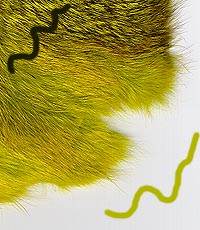
A piece of natural, tanned rabbit after dyeing with picric acid
Picric acid, as said, is a yellow substance, and will impart a yellow colour to whatever it reacts with. A white belly therefore will turn electric yellow. The brown guard hairs of most mammal furs will turn a
yellow brown-green hue. Most feathers (which are shades of brown) will again turn a yellow to brown-yellow hue. The most sought after effect however is what happens with most mammal skins' underfur, which normally is a distinct shade of grey or blue-grey. This grey colour turns into the most gorgeous hues of olive green when 'mixed' with the yellow of picric acid. The results vary from a medium yellow green with the light blue grey underfur of a rabbit to the already mentioned wonderful dark olive from the dark grey underfur of a pine squirrel or grey squirrel. They also tell me that mole skin dyed picric yields interesting colours, although I haven't tried that myself yet...
Happy dyeing
- Log in to post comments


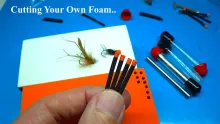
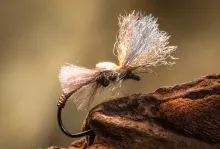
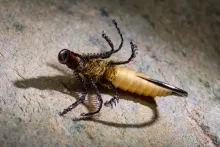

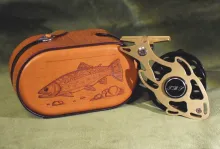

Picric acid was used
Picric acid was used quite frequently in period bookbinding. I would love to have some, as a coat of picric acid and then a coat of potassium carbonate yields a wonderful burnt orange on calf leather. But I don't think I have the cojones.
Gee, it's the Electr
Gee, it's the Electric Kool-Aid Acid Test.
Drop in acid. Tie flies. Catch trout. ;-)
Well, let's put it t
Well, let's put it this way:
-picric acid is toxic; actually quite toxic. But it won't kill you unless you drink/eat it.
-picric acid IS an explosive. It has been used in shells, but it's not THAT sensitive. The door knob story is to scare off the ignorant people. In order to make it explode you need more shock than a standard blasting cap can provide, and that blasting cap alone may be enough to kill you. Still, picric acid readily forms salts with fairly any metal it comes in contact with, salts that are very sensitive to friction, flame and impact. So storing it in solution is a must; keeping it away from metals is also a must.
Concerning the sensitivity, there was some picric acid fire once and the stuff (tones of it) didn't go off; instead it just burned out. During the fire, large steel pieces from the desintegrating warehouse structure kept falling in the puddle of melted burning picric acid hell. Everybody feared a massive blast, but it didn't happen. Now, just put regular fertilizer in the same story and it would have certainly been a huge blast.
If really needed, with a bit of responsability it can be used; there are far more dangerous chems we use every day without even noticing it (caustic soda for instance).
That is not to say that you can take it lightly; it can stain, it has an incredible bitter taste, it's toxic, and it can explode. But it doesn't mean either that while dyeing you fly,instead of dreaming about that huge trout you'll get, you feel cold shivers down your spine thinking "my God, what if it blows up right in my face now?"
Hi Jim
I actually p
Hi Jim
I actually put fly to the acid solution together with hook. I found it more effective. Fly just look better to me. It lets me save the solution as well-is not easy to get some-I got my by accident.
Picric acid is safe
Picric acid is safe in alcohol. If the dyed skin is washed in cold water to remove trace acid it is safe to come in contact with metal.
I made my solution b
I made my solution by mistake from 13% water solution dissolved in alcohol. I asked my friend chemist to prepare for me 5% solut. in 70% alcohol and it works as well .I hope is not dangerous mix it wit alc.?And additionally I dye whole fly not material itself-it contacts with metal hook!!! Am I crazy?
Okay. Picric acid is
Okay. Picric acid is safe...as long as you take precautions. DON'T let it contact any metal. DON'T let it near any sort of flame or heat source (picric acid can be used a booster explosive). ALWAYS store it in water and never let it dry out in storage. keep it at least in a 30-70 solution. 30 percent water and 70 percent acid and keep that jar submerged in a bucket of water. And it would be a great idea to handle it with heavy rubber gloves.
Just a small note to
Just a small note to all who whine about the danger of picric acid: no, it's not kitchen salt! It's a potentially dangerous substance.
But read the article carefully, take your precautions and just remember that the author, Henk Verhaar, is a chemist by training and works with stuff like this as a University employed toxicologist. He does have a slight knowledge about these substances, and I'm sure his instructions are good enough to bring you safely through the process...
And sure: if uncertain, just leave it - or let someone with a lab and an armored suit do your dying. I wouldn't do it myself, but I have some skin dyed with picric acid, and man, it sure is a nice color!
Martin
Ron you seem to not
Ron you seem to not know alot about explosives, a few crystals will not blow your hand off as soon as they become dry, look up secondary explosives on Wikipedia if you don't believe me. I personally have tried to dye cotton with this stuff, I don't recomend doing it to clothing, it weakens the material and won't hold colour. But it can be easily and safely used at home, just keep it away from metal and concrete (it reacts with these) a few drops of this are less dangerous than petrol, it takes a severe amount of friction or shock to detonate and will probably just be carried off in the wind.
I was going to use P
I was going to use Picric acid to dye sprats that beautiful gold colour and individually vacuum pack them for future use when fishing.
This now seems a very dangerous pastime!
Although I never actually got round to doing it, I was told by a friend that he'd made lots of money doing this and selling the dyed sprats packed in pairs in a resealable plastic bag to fishing tackle/bait shops in the area.
Mike Ramsay
I can't help but agr
I can't help but agree.
Picric Acid is NOT for home use.
No fly or fish are worth the consequences.
Would fish really care about the slight colour difference or if you lost your eyes?
Ripley.
Hey
Ron is absolu
Hey
Ron is absolutely right. This is propably the worst advice i have seen on a webpage like this. Picric acid is an explosive. If the solution dries out and crystals are formed you have the recipe for disaster. Dont take my word for it, look it up in wikipedia. I couldnt supply the link here since your forum doesnt allow it but the word explose is coming up a lot there.
It makes the most fantastic colors, BUT its not for non chemist and absolutely NOT for homeuse.
You're nutts. I have
You're nutts. I have been through hazmat classes and you're gona kill yourself or somone around you. One drop of that stuff on a door knob at the turning point and left to dry will blow your hand off. It activates with friction. I highly discurage this method.
dear henk verhaar,
dear henk verhaar,
I'm a fly-tyer from belgium and member of the VVVV (vlaamse vereniging van vliegvissers=flemmish club of fly-fishers near antwerp) during one of our tying sessions our teacher spoke about picric acid ,and therefor I wanted to note that not only skins can be dyed whith the acid but feathers too, especially mallard which give them also that beautifull color you spoke about
Bart Hollebeke
Dyeing with picric acid yields colors between a gorgeous o
I'm confused is Picric Acid yellow dye explosiv or not?
It is explosive
Joe,
The substance pricric acid is indeed explosive and considered quite hazardous. It was previously used in munitions and other explosives. So it's not a trivial substance to handle, but people who know how to store and work with it can usually do so quite safely.
Martin